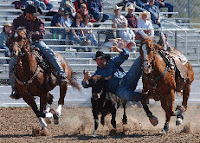
By Deborah Sharp
The question is common at book-signings, workshops and panels: How do you deal with writer's block?
During my days as a newspaper reporter I learned there's no such thing, I tell people. Take one ill-tempered editor with the power to fire you, add a looming deadline you know you must not miss, now sit down at the frickin' computer and write. Abbacadabra, writer's block disappears!
The truth is even the best writer's flow can hit a snag. Not saying MINE has . . . just sayin.'
There's all kinds of advice out there for overcoming that blo ... er, snag. John Steinbeck counseled blocked writers to pretend they're writing to an aunt. P.J. O'Rourke said: ''Write badly. Bad writing is easier.''
The Internet is rife with offers to unblock through meditation and yoga. Hmm ... I've practiced yoga for many years. I wonder if this yogic writing thing could work for ... er, a friend?
I have my doubts about yoga helping my concentration, though. I usually spend about two-thirds of my class thinking about food. Indian food, in particular. Though sometimes I dream about layer cakes, too.
I’ve dabbled in yoga for almost 20 years. But I’m old, so my down dog refuses to learn new tricks and my half-moon pose is more of a crescent. Even so, I’ve pretty much grasped the physical aspect. The meditative part has always been a bit more slippery for me.
Here's my typical yoga class:
Instructor, employing guided imagery:
Imagine the tension in your neck and shoulders floating away.
I’m with her---picturing the stress of the day soaring off; a gray ball of bad energy cushioned in a cleansing white cloud.
Instructor:
Now, relax the muscles in your jaw and throat.
I swallow. My mouth waters. I think:
Wow, some tandoori chicken would taste REALLY good about now.
My meditation skills are even more lame. The teacher is chanting
OMMMMmmmm, and I’m compiling a mental to-do list. She instructs us to center ourselves to the soothing sound of ocean waves. That makes me think of water, which reminds me my dishwasher needs to be unloaded, and the water heater at my mother's house just sprung a leak.
I crack open an eyelid and steal a glance around the room. Am I the only one incapable of clearing my mind?
Hey, who's the hottie with the buff biceps? Haven't seen him in class before. Finally, the instructor clinks her little finger cymbals together:
Binggg . . . Binggg . . . Binggggggg. Class is over. We’re at one with the universe. And I’m that much closer to dinner.
Still, I might be getting more mentally from yoga than I realize. A recent episode convinced me something might be sinking in. Near the end of every yoga session, we can hear the Abs-Workout people clamoring outside the door, wanting in. They’re the stalking tigers of the gym, versus yoga’s fluttering butterflies. When the studio door finally opens, in rush the abs people, nearly trampling the mellow yoga folks.
A few days ago, a twenty-something taut-ie grabbed a floor mat right out of my hand as I was trying to put it away. Once upon a time, I’d have growled, tiger-like, and yanked it back. Instead, I smiled serenely, and bid her
Namaste.
My spirit salutes yours, it means. Which was true in a way, since I had centered myself by imagining her head as a giant slice of coconut layer cake.
Step aside, Frosting Face, I chanted to myself.
Nobody makes me late for dinner.
What do you do to clear your head? Writers, have you ever tried meditation as a cure for blo ... er, a
snag in your writing flow?








































